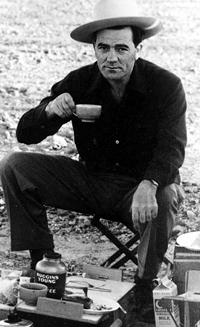"I like them all. There's bits and pieces of books that I think are good. I never rework a book. I'd rather use what I've learned on the next one, and make it a little better. The worst of it is that I'm no longer a kid and I'm just now getting to be a good writer. Just now." (Louis L'Amour)
How did Louis L'Amour, a high school dropout, become one of the most popular writers of all time? He was a lifelong learner.
Louis L'Amour, born in North Dakota in 1908, was the seventh child of Louis Charles LaMoore and Emily Dearborn LaMoore. Louis Sr., a veterinarian, used the family barn for his practice. Louis Jr., gifted with an active imagination, used to use the barn to play cowboys and Indians, a common game for children living on the Frontier.
After a series of bank failures, the LaMoore's were forced to move to where they could find work. Over the next several years, the family skinned cattle in Texas, baled hay in New Mexico, worked the mines of Arizona, Nevada and California, and the lumber camps of the Pacific Northwest. Louis met people of all walks of life, many serving as inspiration for characters in his future novels.
For extra money, Louis boxed in prize fights in small towns, proving to be a formidable opponent. He joined the merchant marine and sailed to Singapore and the West Indies. Whenever he arrived in a new town or city, the first place he would seek out was the local library. He read voraciously. If the town had no library, he would skip meals to buy books. He would scribble notes on cheap notepads with ideas he would later used for his stories.
Louis' first story, Anything for a Pal, was published in 1936 in the publication True Gang Life. Two years later, his stories began to appear regularly in pulp magazines. Louis started to write for Standard Magazine as well. When the U.S. joined World War II, Louis enlisted as a Lieutenant. His war years served as more fodder for his stories.
In 1951, Louis sold his first novel, Westward the Tide. At the time, publishers were reluctant to publish more than one or two books per author. However, with a dozen novels to his credit and with several million copies sold, Louis secured a deal with Bantam Books to write three books per year. He became the king of the Western novel.
While he never acquired much of a formal education, his years on the road served as his education. Showdown at Yellow Butte (1953) came out of his years living on the Frontier. Guns of the Timberlands (1955) came out of his years working in the timber camps. Mohave Crossing (1964) tells the tale of a perilous journey through a treacherous dessert, a true life event for Louis. North to the Rails (1971) features a cattle rancher, another subject familiar to Louis. Cherokee Trail (1982) talks about a woman running a stagecoach station on the Frontier (https://en.wikipedia.org/wiki/Louis_L%27Amour).
In total, Louis penned over 100 novels, 250 short stories, and two non fiction works. His novels were translated into 10 languages. When asked not long before his death which novel he liked the best, Louis explained: "I like them all. There's bits and pieces of books that I think are good. I never rework a book. I'd rather use what I've learned on the next one, and make it a little better. The worst of it is that I'm no longer a kid and I'm just now getting to be a good writer. Just now." Louis was still learning, even at 80 years old. Louis' autobiography, published posthumously, is called Education of a Wandering Man.

No comments:
Post a Comment